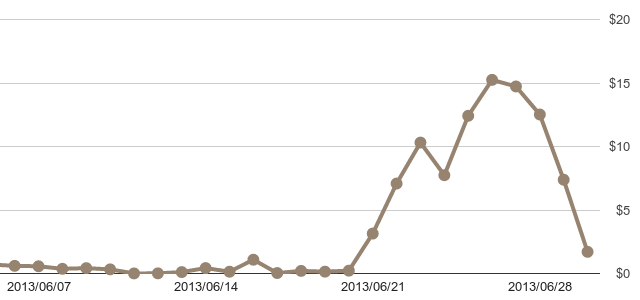Patchy featuring: retrospective
It’s been two weeks since I announced that Patchy was to be featured in the Play Store. This happened roughly a week ago, and it looks like it was taken down around yesterday, so it’s time for a postmortem.
There are different places where an app can be featured. In this case, when you tapped Games, then Play Picks, Patchy was one of 12 games, appearing in the bottom right corner among the likes of Disney and EA Games:

It showed up both on my Galaxy Nexus phone and my Nexus 7 tablet. (No, I don’t have an über-tall tablet, but I do have GIMP.) I couldn’t find a trace of it in the web-based Play Store, though.
Let’s have a look at the numbers. First, the paid version, which is the one that actually was featured. The Daily Device Installs graph looks like this:

At peak, I got over 100 installs a day. The total number of active installs increased by about 400 during this week, and total user installs (i.e. including those that were later uninstalled) increased by 550. At $0.99/£0.50/€0.59 apiece, this makes for a revenue of slightly over $450/£300/€350. Keep in mind that Google will take a 30% cut of this, so the actual profit is more like $315/£210/€245.
The Play Store will let you cancel your order within a 15 minute window after purchase. This happened to roughly one third of all orders (and these are not included in the above revenue numbers). Google Checkout insisted on sending me an email for each cancellation, and the option to turn this off was nowhere in sight. This might have to do with the migration to Google Wallet, but it’s still weird. I ended up creating a Gmail filter to clean up the spam.
Thanks to a reference in the Play Store entry from the paid to the free version, the latter got a lot of exposure as well. Active device installs (which is the interesting metric for an ad-supported app) climbed to over 6600:

And here’s what happened to ad revenue:

Total ad revenue over the app’s lifetime is now around $100/£65/€75. I don’t think the game has enough replayability for this to get much higher at the moment.
Also, interesting things happened to the ratings, for both paid and free versions. They started out near 5 stars, but dropped almost linearly over time to around 3.6 stars. According to several 1-star reviews, there were two causes for this:
- Some mysterious problem with certificates, that I couldn’t reproduce on any of my devices. Apparently it prevented installation for a subset of users. I released a new version yesterday that was signed from the command line using
jarsignerfrom JDK 6 instead of JDK 7 that Eclipse might have used, but I’m not sure if that fixed it. - Random freezes due to bugs in libgdx’s
EarClippingTriangulatorclass. I believe I fixed those with this pull request and released a new version of Patchy that incorporates this code.
Because I was travelling, both fixes came too late to make any difference to the app ratings during featuring. Oh well.
Some lessons learned:
- Try to plan the moment your app features, so you’re actually available to respond to problems. You don’t have much control over timing, but it’s possible to stall a bit on resolving feature-gating problems. In my case, from resolution to featuring took about 9 days.
- Paid apps can make more money than free ones, even (especially?) at a rock bottom price point. In this case, over three times as much. (If it had been the free version to feature, this might have been the reverse, who knows?)
- Beware of Play Store and certificate issues. Sadly, this is impossible to test ahead of time. I’m still not sure if a direct APK install would also have exhibited this particular problem on these devices.
- When setting up your keystore, use an RSA key, not a DSA key (which is the default). Tools will have better defaults for RSA, so there is less risk of error.
- Most importantly: practice! Don’t let your first release be something that you’ve worked on for years – start small to learn the ropes, then gradually increase investment and scope. Patchy was intended as a pilot project to get the hang of sales and post-sales, and has more than achieved that goal. I made more money off it than I expected, but I consider that a bonus.